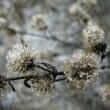Background
- Siberian cocklebur, a member of the Asteraceae family, is an annual plant used in traditional Chinese medicine (TCM). Today, Siberian cocklebur is often used in combination with other herbal products, such as magnolia flower and angelica root. It grows mainly in northern Iran, China, and parts of Asia. The fruit is an egg-shaped burr with numerous hooked spines.
- Siberian cocklebur has been traditionally used for sinus congestion, chronic nasal obstructions and discharges, respiratory allergies, and rheumatoid arthritis. It has also been used to relieve aches and pains, as well as headaches associated with nasal congestion and sinusitis.
- Siberian cocklebur contains toxic chemical compounds, which may cause severe hepatitis with fatal liver failure or interactions with the liver's detoxification systems. Overdosing of Siberian cocklebur may cause severe side effects including coma and death. High-quality human research on the safety or effectiveness of Siberian cocklebur is currently lacking.
References
- An HJ, Jeong HJ, Lee EH, et al. Xanthii fructus inhibits inflammatory responses in LPS-stimulated mouse peritoneal macrophages. Inflammation 2004;28(5):263-270.
View Abstract - Dai YH, Cui Z, Li JL, et al. A new thiaziedione from the fruits of Xanthium sibiricum. J.Asian Nat.Prod.Res. 2008;10(3-4):343-347.
View Abstract - Han T, Li HL, Hu Y, et al. Phenolic acids in Fructus Xanthii and determination of contents of total phenolic acids in different species and populations of Xanthium in China. Zhong Xi Yi Jie He Xue Bao 2006;4(2):194-198.
View Abstract - Hong SH, Jeong HJ, Kim HM. Inhibitory effects of Xanthii fructus extract on mast cell-mediated allergic reaction in murine model. J Ethnopharmacol 2003;88(2-3):229-234.
View Abstract - Li WL, Zheng HC, Bukuru J, et al. Natural medicines used in the traditional Chinese medical system for therapy of diabetes mellitus. J Ethnopharmacol 2004;92(1):1-21.
View Abstract - Li Y, Xu C, Zhang Q, et al. In vitro anti-Helicobacter pylori action of 30 Chinese herbal medicines used to treat ulcer diseases. J Ethnopharmacol 4-26-2005;98(3):329-333.
View Abstract - Liu SM, Yao ZX, Zhang LX. Influence of Fructus Xanthii on reversibility of liver injury and DNA synthesis. Journal of Beijing 2007;30:87-89.
- Sato Y, Oketani H, Yamada T, et al. A xanthanolide with potent antibacterial activity against methicillin-resistant Staphylococcus aureus. J Pharm Pharmacol 1997;49(10):1042-1044.
View Abstract - Stuart BP, Cole RJ, Gosser HS. Cocklebur (Xanthium strumarium, L. var. strumarium) intoxication in swine: review and redefinition of the toxic principle. Vet Pathol 1981;18(3):368-383.
View Abstract - Witte ST, Osweiler GD, Stahr HM, et al. Cocklebur toxicosis in cattle associated with the consumption of mature Xanthium strumarium. J Vet Diagn Invest 1990;2(4):263-267.
View Abstract - Wu ML, Wang CP, Deng JF. Fatal hepatic failure due to fructus xanthii in a child. Clinical Toxicology.Abstracts of the 2005 North American Congress of clinical toxicology annual meeting 2005;43:9.
- Zhang XQ, Ye WC, Jiang RW, et al. Two new eremophilanolides from Xanthium sibiricum. Nat Prod Res 2006;20(13):1265-1270.
View Abstract - Zhao Y, Yang H, Zheng YB, et al. The effects of Fructus Xanthii extract on cytokine release from human mast cell line (HMC-1) and peripheral blood mononuclear cells. Immunopharmacol Immunotoxicol 2008;30(3):543-552.
View Abstract - Zhu HH, Chen YP, Yu JE, et al. [Therapeutic effect of Xincang Decoction on chronic airway inflammation in children with bronchial asthma in remission stage]. Zhong Xi Yi Jie He Xue Bao 2005;3(1):23-27.
View Abstract







